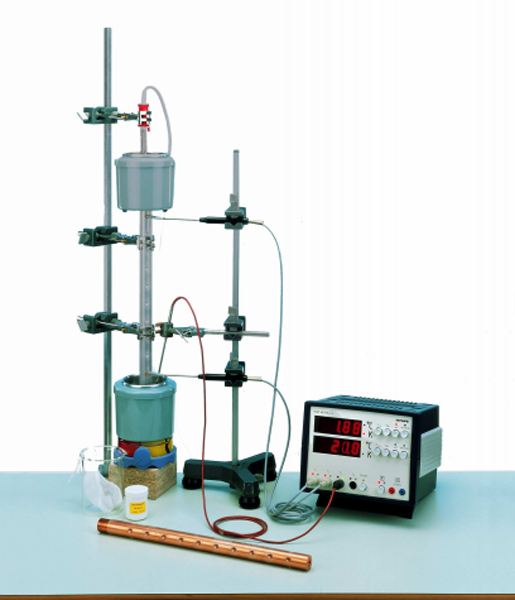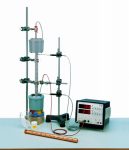Thermal conductivity of metals

Principle
The thermal conductivity of copper and aluminium is determined in a constant temperature gradient from the calorimetrically measured heat flow.
Benefits
- Easy to set temperature gradient
- Compact, easily transportable setup
Temperature probe, immersion type, Pt100
Surface temperature probe PT100
PHYWE Temperature meter digital, 4-2
Magnetic stirrer without heating, 3 ltr., 230 V
Universal clamp
Beaker, 400 ml, low-form
Magnetic stirring bar 30 mm, cylindrical
Portable Balance, OHAUS CL2000J
Tripod base PHYWE
Support rod, stainless steel, 750 mm
Support rod, stainless steel, 1000 mm
Supporting block 105x105x57 mm
Stopwatch, digital, 1/100 s
Heat conductive paste,50 g
Calorimeter vessel, 500 ml
Gauze bag
Calor.vessel w.heat conduct.conn.
Heat conductivity rod, Cu
Heat conductivity rod, Al
Immers.heater,300W,220-250VDC/AC
Right angle clamp expert
Bench clamp expert
Tasks
- Determine the heat capacity of the calorimeter in a mixture experiment as a preliminary test. Measure the calefaction of water at a temperature of 0 °C in a calorimeter due to the action of the ambient temperature as a function of time.
- To begin with, establish a constant temperature gradient in a metal rod with the use of two heat reservoirs (boiling water and ice water). After removing the pieces of ice, measure the calefaction of the cold water as a function of time and determine the thermal conductivity of the metal rod.
What you can learn about
- Thermal conductivity
- Diffusion
- Temperature gradient
- Heat transport
- Specific heat

